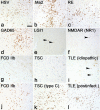Innate and adaptive immunity in human epilepsies
- PMID: 28675562
- PMCID: PMC5535008
- DOI: 10.1111/epi.13784
Innate and adaptive immunity in human epilepsies
Abstract
Inflammatory mechanisms have been increasingly implicated in the origin of seizures and epilepsy. These mechanisms are involved in the genesis of encephalitides in which seizures are a common complaint. Experimental and clinical evidence suggests different inflammatory responses in the brains of patients with epilepsy depending on the etiology. In general, activation of both innate and adaptive immunity plays a role in refractory forms of epilepsy. Epilepsies in which seizures develop after infiltration of cells of the adaptive immune system in the central nervous system (CNS) include a broad range of epileptic disorders with different (known or unknown) etiologies. Infiltration of lymphocytes is observed in autoimmune epilepsies, especially the classical paraneoplastic encephalitides with antibodies against intracellular tumor antigens. The presence of lymphocytes in the CNS also has been found in focal cerebral dysplasia type 2 and in cortical tubers. Various autoantibodies have been shown to be associated with temporal lobe epilepsy (TLE) and hippocampal sclerosis of unknown etiology, which may be due to the presence of viral DNA. During the last decade, an increasing number of antineuronal autoantibodies directed against membranous epitopes have been discovered and are associated with various neurologic syndromes, including limbic encephalitis. A major challenge in epilepsy is to define biomarkers, which would allow the recognition of patient populations who might benefit from immune-modulatory therapies. Some peripheral inflammatory markers appear to be differentially expressed in patients with medically controlled and medically refractory and, as such, could be used for diagnostic, prognostic, or therapeutic purposes. Establishing an autoimmune basis in patients with drug-resistant epilepsy allows for efficacious and targeted immunotherapy. Although current immunotherapies can give great benefit to the correctly identified patient, there are limitations to their efficacy and they may have considerable side effects. Thus the identification of new immunomodulatory compounds remains of utmost importance.
Keywords: Adaptive immunity; Autoantibodies; Encephalitides; Epilepsy; Immunomodulatory drugs; Innate immunity.
Wiley Periodicals, Inc. © 2017 International League Against Epilepsy.
Figures

References
-
- Karim AR, Jacob S. Immunological markers in neurological disorders. Ann Clin Biochem 2012;49:29–43. - PubMed
-
- Bauer J, Lang B, Irani SR, et al. Immune responses in the CNS in epilepsy In Woodroofe N, Amor S. (Eds) Neuroinflammation and CNS disorders. Hoboken, NJ: John Wiley & Sons, 2014:289–315.
Publication types
MeSH terms
Substances
Grants and funding
LinkOut - more resources
Full Text Sources
Other Literature Sources
Medical

